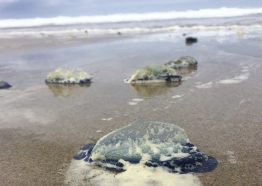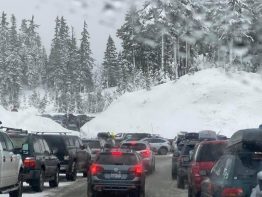Just a few days shy of the first day of spring, scientists at Friday Harbor Laboratories on San Juan Island had reason to celebrate. Dozens of juvenile sea stars, no bigger than a poppy seed, had successfully metamorphosed from floating larvae to mini star — the important first step toward becoming an adult. Between now and then, these sunflower sea stars, the largest sea star species in the world, will grow up to 24 arms and a colorful body the size of a serving platter.
Read more at UW News »‘By-the-wind sailor’ jellies wash ashore in massive numbers after warmer winters
As their name suggests, by-the-wind sailor jellyfish know how to catch a breeze. Using a stiff, translucent sail propped an inch above the surface of the ocean, these teacup-sized organisms skim along the water dangling a fringe of delicate purple tentacles just below the surface to capture zooplankton and larval fish as they travel. At the mercy of the wind, these jellies can wash ashore and strand — sometimes numbering in the trillions — on beaches around the world, including up and down the U.S.
Read more at UW News »Could COVID-19 be helping Alaska’s beluga whales get some ‘me time’?
When you try to imagine what a happy, calm beluga whale looks like, what images do you conjure up? A smiling white blob, reclining on a chaise lounge with a shrimp cocktail? A zen-like cetacean emerging from a meditation workshop session with a rolled-up mat under its flipper? For Manuel Castellote, a researcher at the Cooperative Institute for Climate, Ocean and Ecosystem Studies (CICOES), the image is less absurd but more exciting.
Read more »We’re coping with COVID by going outdoors, but how is nature coping with us?
If you’ve hit the trails or the water this year, you know COVID-19 has transformed the way many people are recreating in our wild spaces. Places that were previously “off the beaten track” are as popular as they’ve ever been, and the usual hotspots are overwhelmed with hikers, campers and skiers. What does this mean for our wild spaces, and how can we be better stewards?
Read more »Marine-related Learning Networks’ role in ocean governance
Healthy ecosystems buzzing with life are more than something pretty to look at – they are critically important to our health and wellbeing. Ecosystems deliver goods and services that humans need – like fresh water, protection from the elements and food for our dinner tables – and it’s in our best interest to make sure they remain vibrant and thriving for future generations.
Read more »





